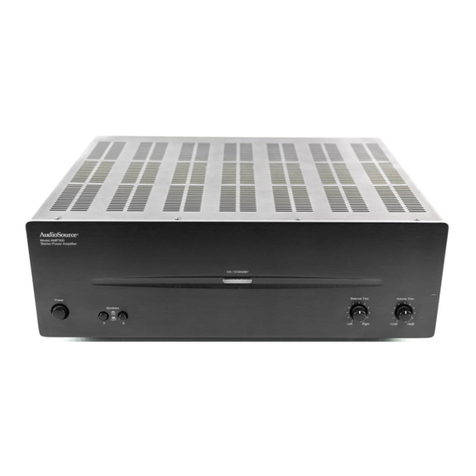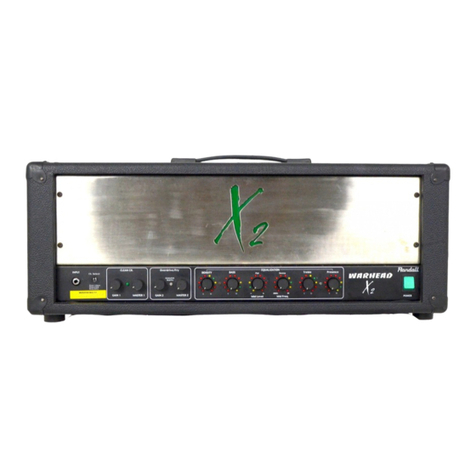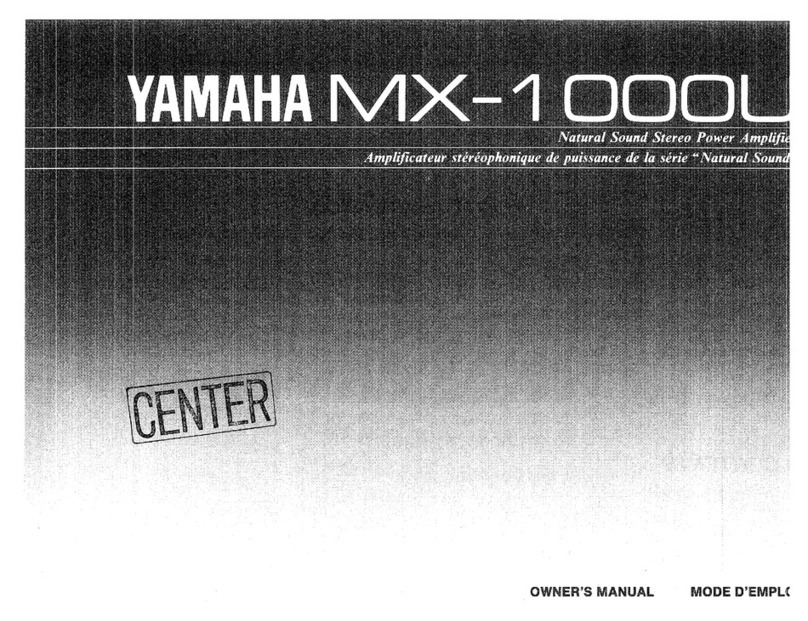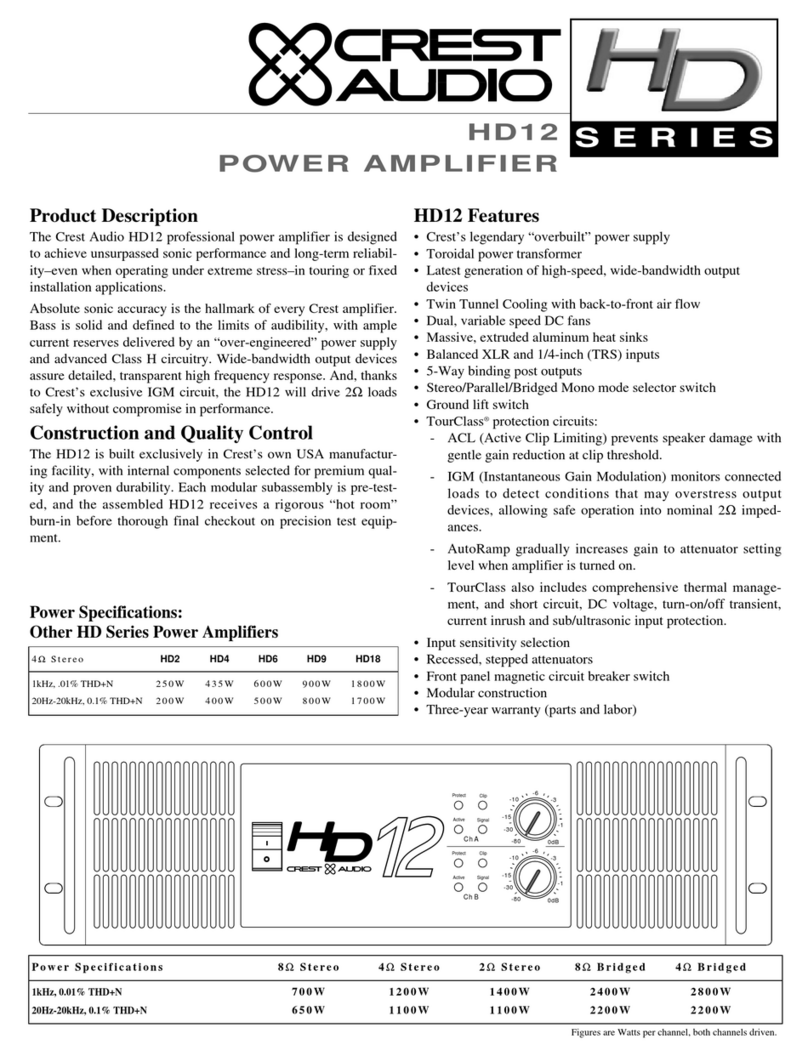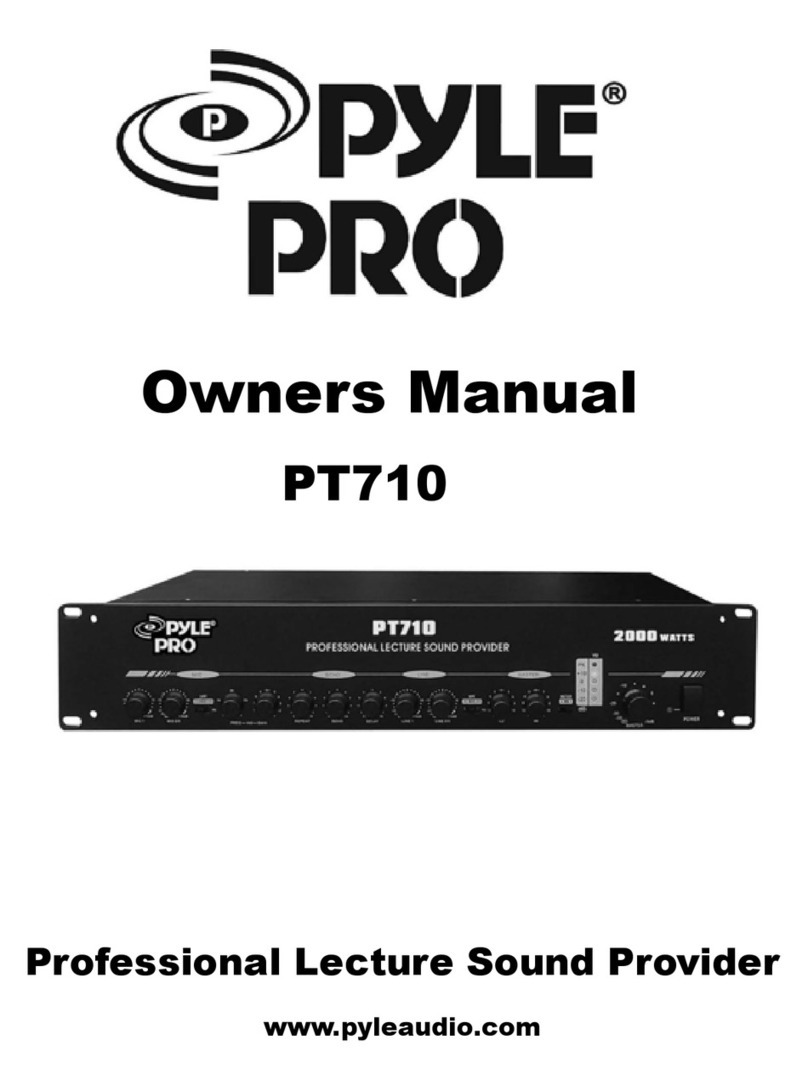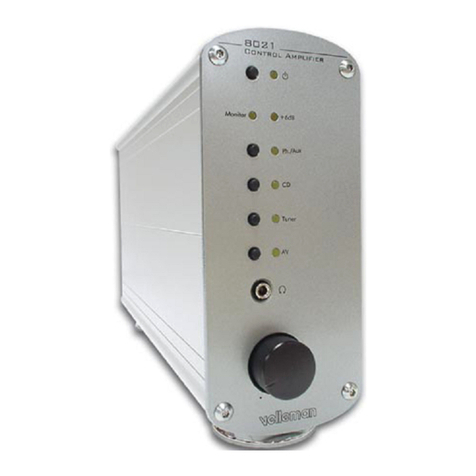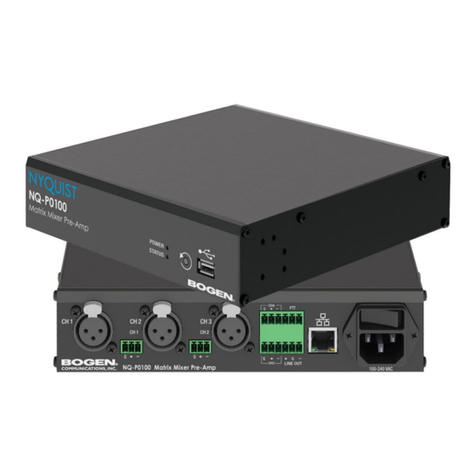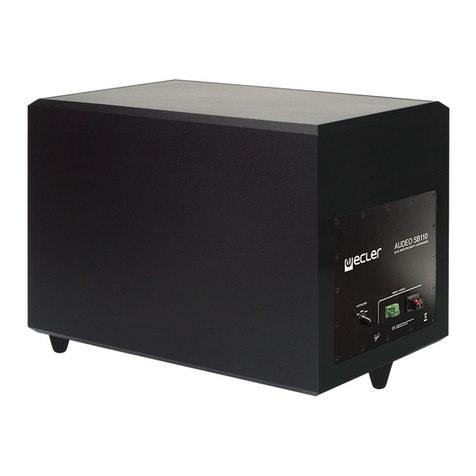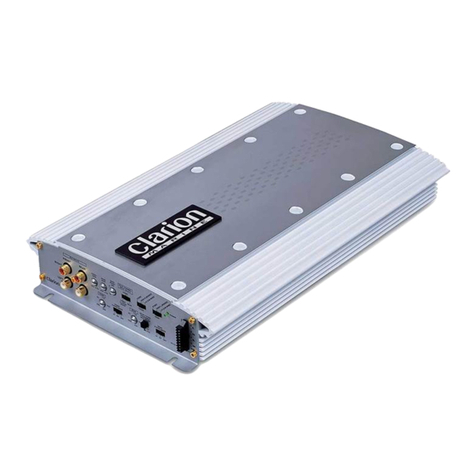Trek 50 User manual

OPERATOR’S MANUAL
MODEL 50/750
HIGH-VOLTAGE AMPLIFIER
TREK INCORPORATED 1 800 367-8735
11601 MAPLE RIDGE ROAD TEL: (585) 798-3140
MEDINA, NY 14103-9710 FAX: (585) 798-3106
www.trekinc.com
50/750 9203

Thank-you
for buying Trek’s Model 50/750 High-Voltage Amplifier. This product has been designed and
built to very high standards to give you years of trouble-free service.
If you have any questions, please feel free to contact your Trek Representative at:
WRITE: TREK, INC.
11601 Maple Ridge Road
Medina, NY 14103-9710 USA
FAX: (585) 798-3106
PHONE: In the United States: 1 800 367-8735 (FOR TREK)
International Customers: (585) 798-3140
Again, thank you for buying a Trek Product.

TABLE OF CONTENTS
GENERAL INFORMATION
Introduction...........................................................................1
Specifications.......................................................................2
Incoming Confidence Test.................................................3
INSTALLATION
Mounting ...............................................................................4
AC Line Cord Connection..................................................4
How to Assemble the High Voltage Connector..............4
Load Connections ...............................................................5
Digital Enable Connection..................................................5
Changing the Output Voltage Range...............................6
OPERATION
Front Panel Controls and Indicators.................................7
Rear Panel Connector........................................................8
Operating Procedure ..........................................................8
Adjusting the Gain...............................................................8
Adjusting the AC Response Controls...............................8
Protective Circuitry..............................................................9
MAINTENANCE
Safety....................................................................................10
Preventative Maintenance .................................................10
Servicing the Fuses ............................................................10
Customer Assistance..........................................................11
APPENDIX A
Active Load Limitations ......................................................A

SECTION I
GENERAL INFORMATION
WARNING: THIS INSTRUMENT IS NOT RATED FOR AN EXPLO-
SIVE ENVIRONMENT. DO NOT USE IT IN AN EXPLOSIVE ENVI-
RONMENT OR AN EXPLOSION MAY OCCUR.
INTRODUCTION
This manual provides instructions to install
and operate the Model 50/750 High-Voltage
Amplifier. The Model 50/750 is a two-channel
amplifier. This manual describes the installa-
tion and operation of a typical channel and
applies to either channel of the instrument.
The Model 50/750 is a high-voltage amplifier
with a 1500-volt output range at 50 mA
continuous, 100 mA peak (for 10 µs into
capacitive or resistive loads). It uses a
floating output driver, allowing the instrument
to be strapped to produce an output voltage
range of 0 V to +1500 V, 0 V to -1500 V or
-750 V to +750 V. As such, the user may
select bipolar of full unipolar operation.
It features adjustable DC gain in the range of
15 to 300 V/V and AC response controls that
permit handling of different capacitive loads.
The four-quadrant output stage sources or
sinks current into capacitive or resistive loads
anywhere within the output voltage range.
1

SPECIFICATIONS
All specifications are with no load unless otherwise noted.
OUTPUT
Output Voltage Range
0 to +1.5 kV DC or peak AC, or
0 to -1.5 kV DC or peak AC, or
0 to ±750 V DC or peak AC
(jumper pin programmable).
Output Current Range
0 to ±50 mA DC, continuous
(100 mA peak for 10 µs).
AMPLIFIER INPUT
Input Voltage Range
0 to ±10 V DC or peak AC.
Input Impedance (Noninverting)
100 kΩ, nominal.
FEATURES
The Model 50/750 consists of a power supply module
with up to two modular amplifier channels which can
be mounted together in a half rack enclosure.
Digital Enable (Power Supply Module)
An input providing a connection for a TTL
compatible signal to turn on and off the high-
voltage output. A TTL low turns on the high-
voltage output. A TTL high turns off the high-
voltage output.
Gain Control
The DC gain of the Model 50/750 can be adjusted
using a potentiometer from 15 to 300 V/V.
Dynamic Adjustment
Two graduated potentiometers are used to
optimize the damping and response of the output
signal.
Zero Adjustment
A multi-turn potentiometer can adjust for zero volt
output when a zero volt input is applied.
PERFORMANCE
DC Voltage Gain
15 to 300 V/V, adjustable.
DC Voltage Gain Accuracy
Better than 0.1% of full scale.
Offset Voltage
Less than ±500 mV.
Output Noise
0 to +1500 V range or
0 to -1500 V range
Less than 50 mV rms to 20 kHz for a 1 nF
load (measured with the true rms feature of
the Hewlett Packard Model 34401A digital
multimeter).
0 to ±750 V range
Less than 60 mV rms to 20 kHz for a 1 nF
load (measured with the true rms feature of
the Hewlett Packard Model 34401A digital
multimeter).
Slew Rate (10% to 90%)
Greater than 125 V/µs.
Large Signal Bandwidth (1% distortion)
DC to greater than 8 kHz.
Small Signal Bandwidth (-3 dB)
DC to greater than 30 kHz.
Settling Time to 1%
Less than 50 µs when critically damped.
Stability
Drift with Temperature
Less than 50 ppm/°C.
Drift with Time
Less than 10 ppm/hr, noncumulative.
2A

SPECIFICATIONS, cont.
All specifications are with no load unless otherwise noted.
GENERAL
Dimensions
148 mm H x 216 mm W x 432 mm D
(5.8” H x 8.5” W x 17” D).
Weight
Model 50/750-1 (one channel)
6 kg (14 lb).
Model 50/750-2 (two channels)
8 kg (18 lb).
High-Voltage Output Connector
MHV coaxial connector.
Amplifier Input
BNC coaxial connector.
Digital Enable Connector
BNC coaxial connector.
Power Requirements
Line Supply
Factory set for one of two ranges:
90 to 127 V AC or 180 to 250 V AC,
at 48 to 63 Hz.
Power Consumption
100 VA, per channel.
AC Line Receptacle
Standard three-prong AC line connector, with
an integral fuse holder, that supplies power to
all the amplifier channels of the instrument.
Operating Conditions
Temperature
0°C to 40°C.
Relative Humidity
To 85% noncondensing.
ACCESSORIES SUPPLIED
Operator’s manual, MHV mating connector for
each amplifier channel, and line cord.
CERTIFICATION
Trek, Inc. certifies that each Model 50/750
is tested and calibrated to specifications
using measurement equipment traceable
to the National Institute of Standards and
Technology or traceable to consensus
standards.
2B

INCOMING CONFIDENCE TEST
The 50/750 undergoes extensive checks
and adjustments at the factory and should
require no initial calibration. However, you
may wish to perform an incoming confi-
dence test as part of the incoming inspec-
tion on the instrument. This incoming
confidence test is intended to confirm that
the instrument was not damaged in transit.
Applying a test signal to the INPUT connec-
tor and measuring the signal at the OUT-
PUT connector constitutes a reasonable
incoming confidence test.
We recommend that you familiarize yourself
with the information in INSTALLATION
(page 4) and OPERATION (page 7) before
performing this test.
WARNING: Do not plug in the 50/750 or
turn it on until instructed to do so. An
electrical shock could result if this pre-
caution is not observed.
Incoming Confidence Test Procedure
The following test requires a DC voltage
reference and a digital voltmeter capable of
withstanding more than 1500 V at its input
terminals.
This test procedure is written for the 50/750
unit configured as a 0 to +1500 V amplifier
or as a -750 V to +750 V amplifier. To test
a 50/750 unit configured as a 0 to -1500 V
amplifier, substitute the value indicated in
parenthesis. Perform this test for each
channel.
1. Insure that the power switch is OFF
before beginning this test.
2. Plug the AC line cord into the AC line
cord receptacle on the rear panel.
3. Plug the 50/750 into a power source.
WARNING: Make no attempt to bypass
the ground prong in the AC line cord.
Any attempt to negate this safety feature
could result in an electrical shock.
4. Connect a digital voltmeter to the OUT-
PUT receptacle on the front panel. Turn
on the voltmeter.
5. Connect a +1 V (-1 V) reference supply
to the INPUT receptacle on the front
panel. Turn on the reference supply.
6. Turn on the 50/750 POWER switch.
7. Note the voltage on the digital voltmeter.
It must indicate +100 V (-100 V).
NOTE: The output voltage of 100 V
(-100 V) will be seen, given a gain
setting of 100 V/V. Readjustment of this
gain can be set using the front panel
GAIN adjustment control.
This completes the Incoming Confidence
Test. Turn off the POWER switch. Discon-
nect the reference power supply and the
digital voltmeter.
3

SECTION II
INSTALLATION
MOUNTING
The 50/750 is designed for operation as a
tabletop instrument.
CAUTION: The 50/750 is air cooled. Do
not impair the airflow through the vent holes
in the top and bottom covers, or the rear-
panel fan.
AC LINE CORD CONNECTION
1. Insure that the 50/750 POWER switch is
off.
2. Plug the AC line cord into the AC line
cord receptacle on the rear panel.
3. Plug the 50/750 into a 115 V power
source.
WARNING: Make no attempt to bypass
the ground prong in the AC line cord.
Any attempt to negate this safety feature
could result in an electrical shock.
HOW TO ASSEMBLE THE
HIGH VOLTAGE CONNECTOR
A load is connected to the 50/750 using the
high-voltage plug provided.
CAUTION: Use only high-voltage coaxial
cables and high-voltage connector plugs
(MHV type). Do not use BNC plugs (they
are typically rated to only 500 V). The MHV
connector provided must be used with a
coaxial cable having a voltage rating of at
least 1200 V rms. The MHV connector will
accept a coaxial cable with an outer dia-
meter up to .212 inches or 5.4 mm.
Connect the HV plug to the cable as follows:
1. Cut the cable and square up the end.
Strip the cable jacket back 0.65 in.
2. Slide the connector parts onto the cable
jacket. Slide the nut on first, next the
washer, then the gasket, and finally the
clamp. The clamp’s inner shoulder
should fit squarely against the end of the
cable jacket.
3. With the clamp in place, comb out the
braid and fold the fibers back over the
clamp. Trim the center conductor to
0.15 in. Tin the center conductor.
4

4.Solder the contact onto the conductor
through the solder hole. The contact
should butt flush against the dielectric.
Remove excess solder from outside of
the contact.
CAUTION: Avoid applying excess heat
to the contact. This will cause the
dielectric to swell and interfere with the
connector body.
5. Push the contact assembly into the con-
nector body. Screw the nut into the
body with a wrench until tight. Do not
rotate the connector body on the cable
assembly to tighten.
This completes the high voltage connector/
cable assembly procedure.
LOAD CONNECTIONS
Load connections should be made as short
and direct as possible.
1. Connect the center conductor of the
high-voltage cable to the “hot” side of
the load.
2. Return the low side of the load to the
shield of the coaxial cable or to the
green, five-way binding post on the rear
panel of the amplifier.
DIGITAL ENABLE CONNECTION
The DIGITAL ENABLE connection is made
at the DIGITAL ENABLE BNC connector on
the front panel of the POWER SUPPLY
module. To control the 50/750 from a
remote device, connect this input to ground
through a switch or relay contact, or connect
it to the output of a controlling device such
as an open collector transistor or TTL gate
that has a current sinking capability of
approximately 2 mA. When contact is made
from the center post to ground (or the BNC
connector shield), both channels are
enabled. When contact is broken, the high-
voltage rails to both channels are disabled.
When a remote enable/disable function is
not required, connect the cap over the
DIGITAL ENABLE receptacle. This shorts
the DIGITAL ENABLE input and allows the
50/750 to operate.
INPUT CONNECTIONS
To prevent noise pickup, the ground refer-
ence for the input signal must be connected
to the input BNC connector shield. See
diagram below.
5

CHANGING THE OUTPUT VOLTAGE
RANGE
The 50/750 output voltage can be pro-
grammed for any of the three output voltage
ranges: 0 to +1500 V, 0 to -1500 V, or -750
V to +750 V. The programming is accom-
plished by a programming plug located on
the power supply module. The program-
ming plugs are supplied with the loose-parts
kit that accompanies the instrument. Pro-
gramming plugs for 0 to +1500 V and for 0
to -1500 V are supplied in the loose-parts
kit. The programming plug for -750 V to
+750 V is installed on the power supply
module.
NOTE: Observe the following safety precau-
tions when changing the output voltage
range of the 50/750 unit:
1. Hazardous voltages exist within the
instrument enclosure. Always turn off
the 50/750 and disconnect it from its
power source before attempting to make
any output voltage range wiring
changes. Failure to observe this
precaution could result in electrical
shock.
2. Allow a cool-down period to reduce the
danger of burns from heated parts such
as transistors and heat sinks.
3. Refer all maintenance procedures to
qualified personnel.
Locating the Programming Plug
Remove the power supply module. The
programming connector is a white Molex
connector that is located at the rear of the
power supply board near the gold PC fin-
gers.
Programming the Output Voltage Range
Connect the appropriate programming plug
for the output voltage range required to the
programming connector on the power sup-
ply board.
Install the programming plug so that the
ridge of the plug faces away from the gold
fingers of the power supply board.
6

SECTION III
OPERATION
FRONT PANEL CONTROLS and INDICATORS
Refer to figure below for the location of the
controls and indicators.
1. POWER Switch: This switch turns the
50/750 on and off. A red lamp in this switch
assembly glows when the 50/750 is on.
2. DIGITAL ENABLE: Connect a switch,
relay, or TTL control signal to this input to
turn the high voltage on and off.
3. H.V. OUTPUT: This receptacle, using the
MHV connector (provided), is for the
connection to the load device.
4. AMPLIFIER INPUT: This BNC input
connector is for the connection to an
external, low voltage signal source.
5. GAIN Control: The gain control allows the
user to adjust the DC gain from 15 to 300
V/V. The gain is factory set at 150 V/V
unless otherwise specified when ordered.
6. DAMPING Control: Use this control in
conjunction with the RESPONSE control to
optimize the step response characteristics
of the amplifier.
7. RESPONSE Control: Use this control in
conjunction with the DAMPING control to
optimize the step response characteristics
of the amplifier.
8. ZERO Control: Use this control to produce
zero voltage at the OUTPUT when the input
signal is zero.
7

REAR PANEL CONNECTOR
The rear panel includes a green, five-way
binding post. This is a return connection for
the low side of the load and/or a ground ref-
erence point for other equipment.
OPERATING PROCEDURE
The 50/750 may be used as either a high-
voltage amplifier or as a high voltage refer-
ence supply. The operation is the same for
both applications: an external, low voltage
signal is applied to the input connector and
a proportional high-voltage signal is deliv-
ered through the output connector to the
load device.
WARNING: The high-voltage OUTPUT con-
nector carries high voltage. DO NOT touch
the high voltage OUTPUT connector or the
load circuit while the 50/750 is operating.
An electrical shock could result. Always
turn off the amplifier before making changes
to the load connection.
1. Ensure that the POWER switch is off
before connecting the input signal and
the load.
2. Connect the input signal to the INPUT
receptacle. Ensure that the amplitude of
the input signal does not exceed the
input voltage range specified for the
selected channel and that the source
current is limited to 100 mA.
3. Connect the output signal to the load
circuit using the high-voltage connector/
cable assembly previously constructed.
4. Turn on the POWER switch.
ADJUSTING THE GAIN
NOTE: Unless a different gain was speci-
fied at the time of order, the gain was set at
150 V/V when the 50/750 was shipped from
the factory.
To set the Gain for a different value:
1. Ensure that the 50/750 POWER switch
is off before connecting the input signal
and the digital voltmeter.
2. Connect the output of a DC reference
supply to the INPUT of the 50/750.
3. Connect the output signal to a digital
volt-meter. Ensure that the digital
voltmeter has an input voltage rating
higher than ±1500 V.
4. Turn on the POWER switch.
5. Adjust the gain potentiometer until the
desired gain is obtained. The gain pot is
accessed through the GAIN hole in the
front panel. Use a small screwdriver,
preferably nonconductive.
ADJUSTING THE AC RESPONSE
CONTROLS
As shipped from the factory, the AC
response controls, RESPONSE and DAMP-
ING, are optimized for a no-load condition.
You may desire to readjust these controls
for your load.
NOTE: If it is not feasible to apply the test
signal stated below to your particular load
device, substitute an equivalent RLC load
for the purpose of setting the AC response
controls.
Optimizing the AC Response with a Load
Connected
1. Apply a 100 Hz square wave to the input
of the 50/750. The amplitude of the
square wave must cause a full scale
output excursion: ±5 V in for -750 V to
+750 V out, 0 to +10 V in for 0 to +1500
V out, and 0 to -10 V in for 0 to -1500 V
out (values for a gain of 150).
8

2. Monitor the output of the 50/750 with an
oscilloscope. Use a compensated high-
voltage probe with the oscilloscope if
necessary to limit the oscilloscope input
to a safe voltage level.
3. Adjust the DAMPING and RESPONSE
potentiometers for the best square wave
response (no undershoot or overshoot
and flat tops).
Given the fast response and high
stability of this amplifier, fine wave-
shapes are obtainable. When viewing
the waveshape under certain loads, a
slight overshoot may exist that will not
be adjusted out using the DAMPING
and RESPONSE potentiometers. This
helps maintain the high speed of
response of the amplifier.
PROTECTIVE CIRCUITRY
The Model 50/750 includes internal protect-
tion for high reliability.
Current Limiting
The Model 50/750 is a voltage-regulated
amplifier by controlling output current. The
output current is internally limited for protec-
tion against short circuits and overloading
conditions.
Thermal Limiting
The Model 50/750 is forced-air cooled to
remove any internal accumulation of heat.
If the internal temperature of the amplifier
rises above a safe level, the amplifier will
automatically reduce its output current
capability until the amplifier returns to a safe
area of thermal operation.
Overvoltage Protection
The Model 50/750 is designed for driving
active loads (loads capable of returning
energy into the output of the amplifier). It
incorporates output terminal voltage protect-
tion against high voltage from the load. If
the voltage at the load exceeds approxi-
mately 15% of the rated output voltage of
the amplifier, an internal clamp absorbs
additional energy from the load.
When the voltage of an active device (load)
is within the output voltage range of the
50/750, there is no practical limitation to the
amount of energy that the 50/750 must
absorb.
However, a limitation for the amount of
energy the 50/750 can absorb occurs when
the voltage of the active device exceeds the
voltage range of the 50/750. The amount of
energy that the output can absorb is a com-
plex function of the voltage, of the duration
of the current, and their effects upon differ-
ent components in the protective circuit. A
discussion of this limitation is given in
Appendix A.
9

SECTION IV
MAINTENANCE
SAFETY
Observe the following safety precautions
when performing maintenance procedures
on the 50/750:
1. Hazardous voltages exist within the
instrument enclosure. Always turn off
the 50/750 and disconnect it from its
power source before cleaning or
inspecting it. Failure to observe this
precaution could result in an electrical
shock.
2. Allow a cool-down period to reduce the
danger of burns from heated parts such
as transistors and heat sinks.
3. Refer all maintenance procedures to
qualified personnel.
PREVENTATIVE MAINTENANCE
Preventative maintenance consists of
inspecting and cleaning the instrument.
Preventative maintenance performed on a
regular basis may prevent instrument failure
and improve reliability.
ACCESS: Remove the top cover to expose
all assemblies for inspection and cleaning.
INSPECTION: Visually inspect the instru-
ment for loose or damaged components or
other undesirable conditions such as heat-
damaged parts.
CLEANING: Clean the 50/750 as operating
conditions require. Dust and dirt on
components act as an insulating blanket and
prevent efficient heat dissipation. This can
cause overheating and component failure.
Dust and direct also provide an electrical
conduction path that can result in instrument
failure, especially under conditions of high
humidity that can cause arcing in the high-
voltage sections.
Use dry, low-pressure compressed air to
blow the accumulated dust and dirt from the
interior of the instrument. Use a brush to
dislodge dirt and dust that is not readily
dislodged by the compressed air.
Clean the exterior of the instrument with an
equal part solution of denatured alcohol and
water. The use of stronger solvents may
damage the finish or plastic components. A
small brush is effective in removing dirt from
the front and rear panel controls and
connectors.
SERVICING THE FUSES
WARNING: Never attempt to service the
fuses when the instrument is plugged into a
power source. An electrical shock could
result. Refer servicing of the fuses to
qualified personnel.
1. Disconnect the 50/750 from its power
source before changing the fuses.
2. Remove and replace the fuses with new
ones of the same style and value.
If the 50/750 continually blows fuses, a more
serious problem may exist within the
instrument. In this instance, contact the
Customer Service Department at Trek, Inc.
and request instructions.
10

CUSTOMER SERVICE ASSISTANCE
In the event that you require assistance on a
maintenance item, direct your request for
assistance to the Customer Service Depart-
ment at Trek, Inc.
Telephone assistance is usually effective for
obtaining additional maintenance information
that is beyond the scope of this manual.
Troubleshooting advice that is given over the
telephone may be useful for solving the
simpler malfunctions or confirming that the
instrument should be returned to the factory
or to an authorized service organization for
repair.
Factory Repairs:
The terms and conditions of the warranty are
given in the warranty statement that is found
in this manual.
CAUTION: The warranty is voided if the
instrument is serviced within the warranty
period by anyone other than Trek, Inc. or
one of its authorized service organizations.
In the event of a malfunction, and the
instrument must be returned to the factor for
repair:
a) Notify the Customer Service Department
at Trek, Inc., giving full details about the
difficulty, including the model number
and serial number of the instrument.
Obtain a return authorization number,
which will be issued by the Customer
Service Department.
b) If a return authorization number is issued,
forward the instrument (prepaid) with the
return authorization number prominently
displayed on the shipping container and
the packing list, to Trek, Inc. for repair.
If we determine that the malfunction is not
covered by the terms and conditions of the
warranty, an estimate will be submitted for
customer approval before the commence-
ment of repairs.
FAX: (585) 798-3106
TELEPHONE:
In the United States
1 800 367-8735 (FOR-TREK)
International Customers
(585) 798-3140
11

APPENDIX A
ACTIVE LOAD LIMITATIONS
The Model 50/750 is designed for driving
active loads. Active loads are loads capable
of returning energy into the output of the
amplifier. An example of an active load is a
piezoelectric transducer. A piezoelectric
transducer will develop a voltage across
itself when forced to expand or contract.
The amount of energy that can be generated
by the piezoelectric transducer or any active
load is determined by the formula:
Energy in joules = 1/2CV2,
where C is the capacitance value of the
active load and V is the voltage created by
the stress on the active load.
When the voltage created by an active load
is within the output voltage range of the
50/750, there is no practical limitation to the
amount of energy that the 50/750 must
absorb.
However, a limitation for the amount of
energy the 50/750 can absorb occurs when
the voltage created by the active device
exceeds the voltage range of the 50/750.
The amount of energy that the output can
absorb is a complex function of the voltage,
of the duration of the current, and of their
effects upon different components in the pro-
tective circuit.
A limitation for the amount of energy that the
50/750 can absorb is based on the maximum
energy that certain components in the
50/750 can dissipate. Please refer to Figure
1 for the following discussion. D1 and D2
become forward biased when the voltage
created by the active device exceeds the
value of V1 or V2. (V1 and V2 represent the
high voltage supplies of the 50/750.) When
this occurs, V1 or V2 act as capacitors and
begins charging until the voltage rating of
ZD1 or ZD2 is reached. At this point ZD1 or
ZD2 absorbs the energy produced by the
active load.
NOTE: ZD1 and ZD2 are idealized repre-
sentations of different components in the
50/750. The specific components (zener
voltage values) are different when the
50/750 is operated in different output voltage
ranges.
A1

To calculate the maximum energy in joules
that the ZD1 and ZD2 can dissipate, use the
formula:
Maximum energy in joules = (Vm)(Is)(Ts),
Where V
mis the voltage rating of ZD1 or
ZD2, I
sis the maximum surge current that
ZD1 or ZD2 can absorb for a certain duration
(Ts), and Tsis the maximum duration of the
particular surge current from the load that
ZD1 and ZD2 can withstand. The calcula-
tions for the different voltage ranges of the
50/750 are shown in Table 1.
Now the energy that can be supplied by an
active load can be compared to the
maximum energy dissipation of the 50/750
for a certain output voltage range.
If the energy that can be supplied by the
active load device is greater than the
maximum energy dissipation of the 50/750
for a certain output voltage range, then
additional external protection is required.
Some examples of external protection are
adding series impedance to the output or
using a spark gap device.
TABLE 1
VOLTAGE
RANGE
DESIGNATION
VOLTAGE
RATING
NONRECURRENT
SURGE
CURRENT (MAX.)
CURRENT
DURATION
(MAX.)
MAXIMUM
ENERGY
(in Joules)
0 to ±750 V
ZD1
ZD2
+1000 V, ±5%
-1000 V, ±5%
0.005 amps
0.35 amps
0.85 amps
2 amps
continuous
100 ms
10 ms
1 ms
-
35
8.5
2
0 to +1500 V
0 to -1500 V
ZD1
ZD2
+2000 V, ±5%
-2000 V, ±5%
0.005 amps
0.35 amps
0.85 amps
2 amps
continuous
100 ms
10 ms
1 ms
-
70
17
4
0 to +1500 V
0 to -1500 V
ZD2
ZD1
-115 V, ±10%
+115 V, ±10%
0.01 amps
1.2 amps
2 amps
5 amps
continuous
100 ms
10 ms
1 ms
-
13.8
2.3
0.575
A2
This manual suits for next models
2
Table of contents
Popular Amplifier manuals by other brands

Cloud
Cloud 46 Series Installation and user guide
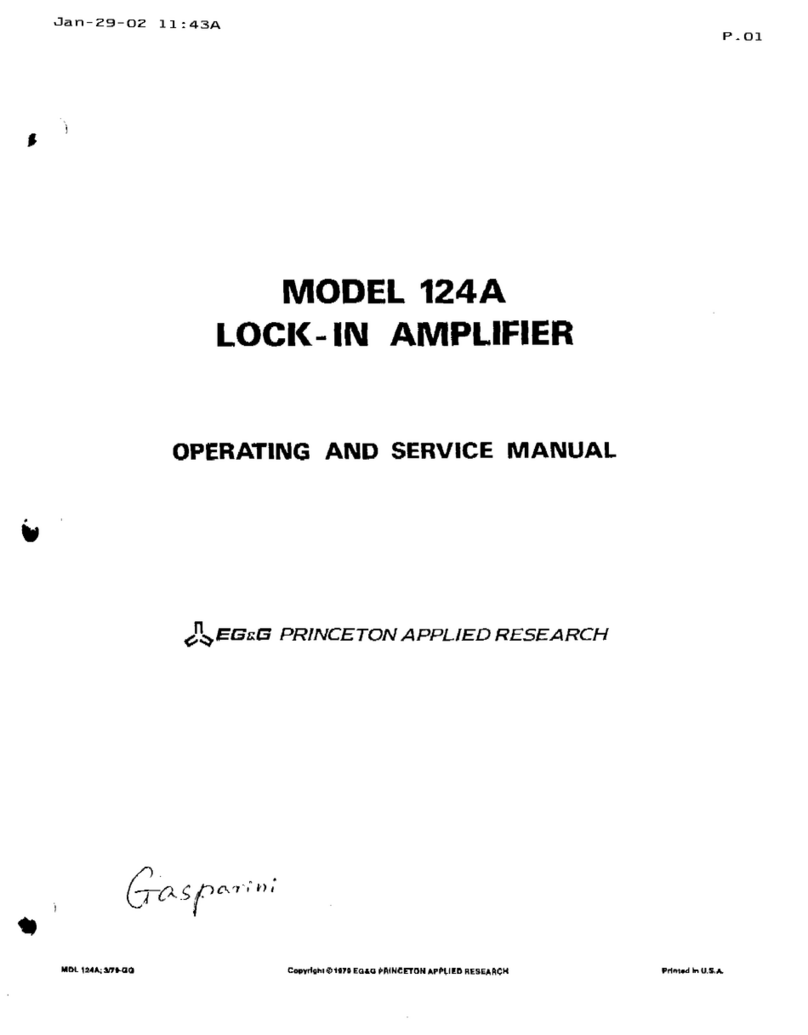
Princeton
Princeton 124A Operating and service manual
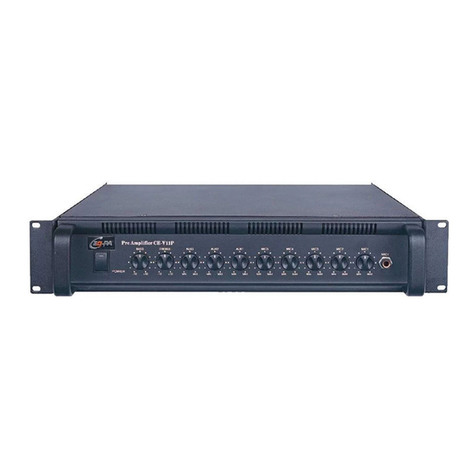
CEOPA
CEOPA CE-1070P user manual
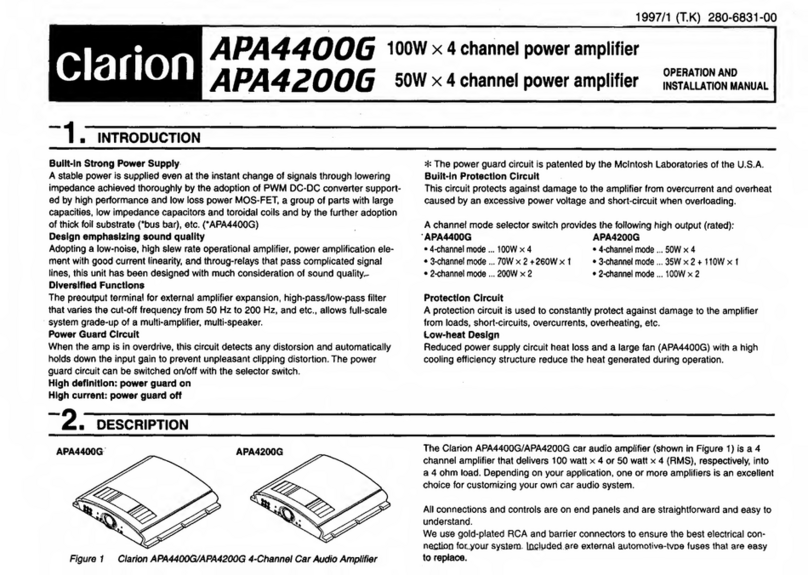
Clarion
Clarion APA4400G Operation and installation instructions
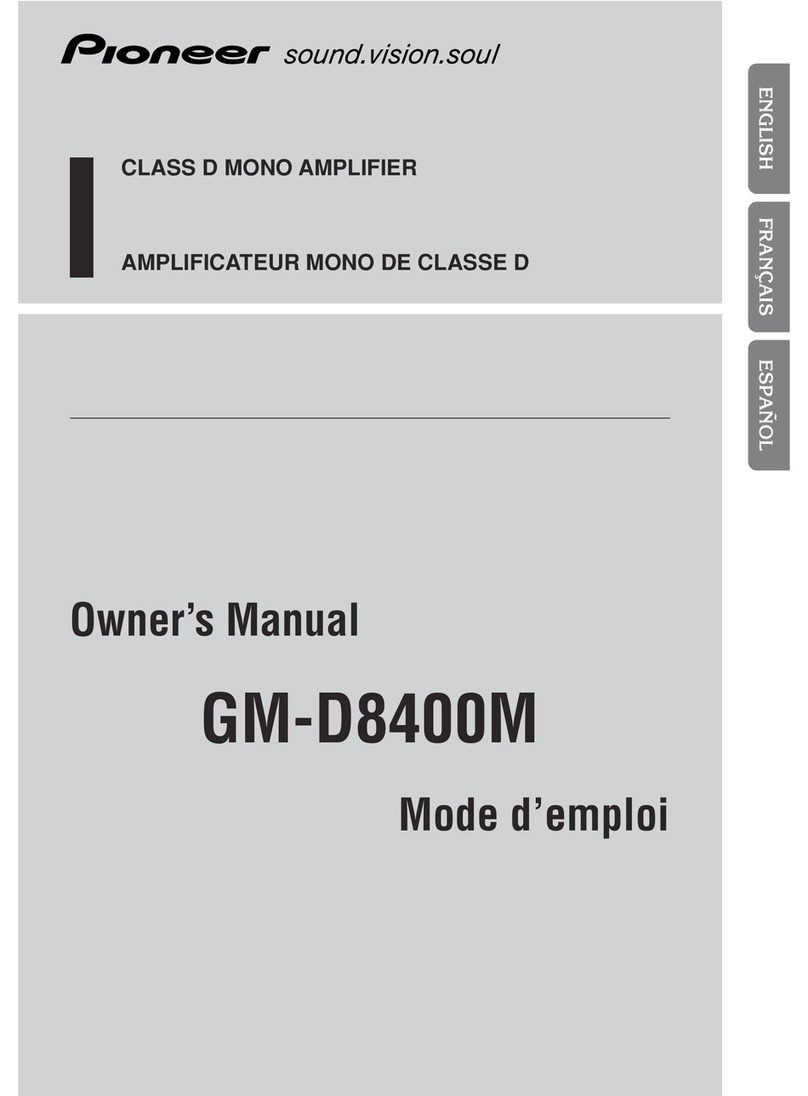
Pioneer
Pioneer GM-D8400M - Amplifier owner's manual
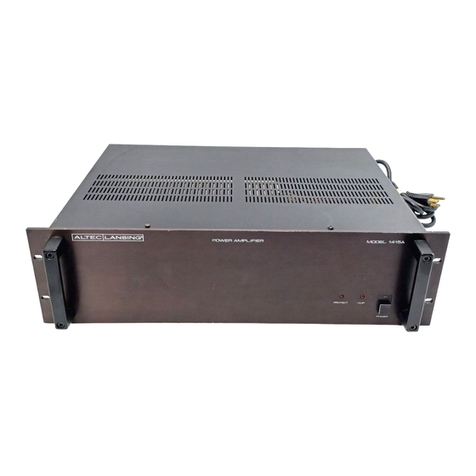
Altec Lansing
Altec Lansing 1407A POWER AMPLIFIER Specifications
